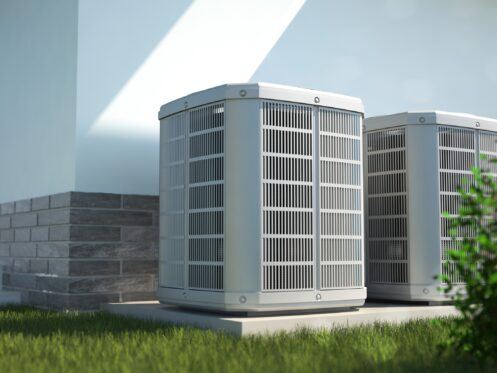If you’re looking to buy a new heating and cooling system for your home, heat pumps and ductless mini-splits are two of the most popular types of HVAC units on the market. While both of these systems are capable of heating and cooling a home, they do so in different ways. Whether you’re replacing an old HVAC unit or installing one for the first time, you should know how these types of HVAC systems differ.
What Are Heat Pumps?
Heat pumps are designed to provide a home with temperature control. These systems allow you to perform cooling and heating actions. When you choose to cool a room, heat is removed from your indoor air before being transferred outside. The opposite action takes place when the outdoor temperatures are colder. One reason why these systems are among the most highly sought ones on the market is because they offer high energy efficiency. Since they perform the functions of a heater and air conditioner, you won’t need to install two separate systems in your home.
The primary issue with this type of system is that its overall efficiency will worsen when the outdoor temperature is around 30 degrees Fahrenheit or below. Since these systems work by effectively absorbing heat from outdoor air before transferring it inside, it will be difficult for the system to function properly when the outdoor temperatures are freezing. Keep in mind that the majority of heat pumps use ductwork to distribute air in a property.
If you choose to have a heat pump installed in your home, you’ll benefit from more efficient cooling and heating, a sleek appearance, and more affordable installation. However, custom control of different zones throughout your home isn’t possible. You’ll also need ducts in your home for a heat pump to run as intended.
What Are Ductless Mini-Splits?
A ductless mini-split is a type of HVAC system that can provide your home with heating and cooling. However, not every mini-split unit is designed to deliver heating into the home. Some of these units will only cool indoor air, which makes them the most useful during the hot summer months. This system uses heat transference to maintain indoor air temperatures.
All mini-split units are ductless, which means that the air will be distributed through relatively small openings. One notable feature of a mini split is its compact size. You can mount these units on your ceiling, walls, or floors. Mini-split units are also highly energy efficient and are capable of controlling temperatures in multiple zones.
The primary advantages of using a mini-split include its ductless functionality, energy efficiency, flexible installation, and customizable control system. However, installation of these units can be costly. They also have a bulky appearance despite their compact size.
How Ducts Work
The main difference between heat pumps and mini-split units involves ducts. Even though mini-split units don’t require ducts to move air throughout the home, the majority of heat pumps do need them. Before having a heat pump installed on your property, make sure that you already have a duct system in place.
Air ducts are concealed passages in a home that are made from sheet metal. When an HVAC system is running, the ducts disperse cooled or heated air to different areas of the home. Air ducts are capable of pushing air to different rooms via small vents that are positioned on walls or floors. Because ductwork is installed around every area of your home, you’ll be able to deliver air to all rooms at the same time.
Even though ductwork is highly beneficial, there are a few downsides. For one, not every room in your home needs the same amount of cooling or heating, which means that the temperature in your home isn’t being maintained efficiently. Your bedroom likely needs more heating and cooling than your kitchen.
In the event that your property doesn’t currently have a ductwork system, installing one is oftentimes too complex and costly. If your home isn’t equipped with ducts, you may benefit from a ductless mini-split system.
Additional Points of Difference
While mini-split units and heat pumps have their similarities, they also have many unique features and advantages, which includes everything from how the unit is controlled to the amount of energy the system loses.
Unit Control
Ducted heat pumps are designed to push cool or hot air into all areas of a building via the ductwork. With this system, every area of your home can benefit from being uniformly warm or cool. Mini-split systems are best used for customized and individualized temperature control. When you select a single-zone unit, it will manage the heating and cooling in just one area of the home. Multi-zone systems allow you to manage the heating and cooling for several areas.
Heating and Cooling Functionality
There are several different heat pump models, which include a ductless version of a heat pump. Mini-split systems can either be air conditioners or heat pumps. When you purchase a heat pump for your home, you’ll receive heating and cooling functionality. On the other hand, not every mini-split system accommodates heating and cooling. Single-zone systems may solely act as air conditioners.
Installation Process
If your home already contains ductwork, the installation process for heat pumps is relatively straightforward. However, mini-split systems are somewhat more difficult to install. Both of these installation processes should be handled by an expert who knows what they’re doing and can keep mistakes to a minimum.
Operational Costs
Ducted heat pumps are centralized systems that are capable of regulating the temperature throughout every room in your home. During this process, more energy is used. Mini-split systems are made to be used in specific zones throughout your home. Every room can have its own air handler, each of which comes with a remote. You can reduce energy use and operational costs by only placing the mini-split system in certain rooms.
Energy Loss
Heat pumps are known to be highly energy efficient. However, some of the energy that the system uses is lost when the air passes through the ducts in your home. If you have ducts, it’s important that their sealing is in great condition. When using a ductless mini-split, there’s no chance that you’ll lose energy while air is circulating through your home. If you want the system with the most efficient design, search for ones that have the highest SEER2 ratings.
Whether you go with a heat pump or ductless mini-split as your HVAC system of choice, our HVAC technicians have the tools and experience necessary to install the system with care. Our team at Level 9 Heating, Cooling, and Plumbing provides Washington, MO residents with repair, maintenance, and installation services for all types of HVAC systems.
If your existing heat pump is malfunctioning, we’ll diagnose the issues quickly to ensure that it’s up and running in no time. We also offer a selection of indoor air quality and commercial HVAC services. Contact us today to schedule our HVAC installation services.



